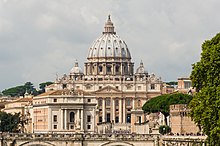Theology of the Priesthood (Catholic Church)
| Part of a series on the |
| Catholic Church |
|---|
 |
| Overview |
|
|
The theology of the Catholic priesthood is rooted in the priesthood of Jesus Christ, who is considered the eternal High Priest of the New Covenant[1]. The Catholic priesthood is understood as a continuation of the priesthood established in the Old Covenant, now fulfilled in Christ[2]. Catholic teaching holds that priests are ordained to act in persona Christi ("in the person of Christ") in administering the sacraments, preaching the Gospel, and shepherding the faithful[3].
Jewish Priesthood
The origins of the priesthood trace back to the Old Testament, where Moses designated Aaron and his descendants from the tribe of Levi as priests to mediate between God and the people of Israel[4]. These priests performed sacrificial rites, offered incense, and maintained the holiness of the Tabernacle and later the Temple in Jerusalem[5].
The Levitical priesthood required repeated sacrifices for atonement[6]. Christian theology teaches that Jesus Christ, as the Messiah, became the eternal High Priest, offering himself as the perfect and final sacrifice for the redemption of humanity[7].
The Priesthood of Christ
Catholic doctrine teaches that Jesus Christ uniquely fulfilled the threefold office of prophet, priest, and king[8]. As High Priest, He offered himself as the perfect sacrifice on the cross and continues his priestly intercession in heaven[9].
According to the Epistle to the Hebrews, Christ's priesthood is of the order of Melchizedek, rather than the Levitical priesthood[10]. Unlike the priests of the Old Covenant, Christ's priesthood is eternal, and his singular sacrifice suffices for all time[11].
The Sacrament of Holy Orders
The Sacrament of Holy Orders is the means by which the priesthood of Christ is perpetuated in the Church[12]. Through this sacrament, bishops, priests, and deacons are ordained into a hierarchical structure that reflects the apostolic ministry[13].
Three Degrees of Holy Orders
The Catholic Church recognizes three degrees within Holy Orders[14]:
- The bishop (episcopate) possesses the fullness of the priesthood and has the authority to ordain others[15].
- The priest (presbyterate) serves as a co-worker with the bishop, administering sacraments and leading a congregation[16].
- The deacon (diaconate) assists priests and bishops, focusing on ministry, charity, and the liturgy[17].
The Eucharistic Sacrifice
The priesthood is most closely linked to the Eucharist, which the Church considers the central act of worship[18]. Catholic doctrine holds that, during the Mass, the priest consecrates bread and wine, transforming them into the Body and Blood of Christ through transubstantiation[19].
According to Catholic theology, the Eucharistic sacrifice makes present the one sacrifice of Christ on Calvary, though in an unbloody manner[19]. The priest acts in the person of Christ (in persona Christi) during this sacred rite[20].
Apostolic Succession
The Catholic priesthood derives its authority through apostolic succession, the unbroken transmission of spiritual authority from the Apostles to the present-day bishops and priests[21]. The Church maintains that only bishops, as successors of the Apostles, have the power to ordain new priests and bishops[22].
Celibacy and the Priesthood
The Latin Rite of the Catholic Church requires priests to take a vow of clerical celibacy, except in rare circumstances such as the ordination of married converts from Anglicanism or Orthodoxy[23]. Celibacy is seen as a sign of total devotion to God and the Church, following the example of Christ[24].
In the Eastern Catholic Churches, married men may be ordained to the priesthood, though bishops are always chosen from among celibate clergy[25].
See also
- Priesthood in the Catholic Church
- Holy Orders
- Eucharist in the Catholic Church
- Apostolic succession
- Sacramental theology
References
- Herbermann, Charles, ed. (1913). "Priest". Catholic Encyclopedia. New York: Robert Appleton Company.
- Herbermann, Charles, ed. (1913). "Priesthood". Catholic Encyclopedia. New York: Robert Appleton Company.
- Herbermann, Charles, ed. (1913). "Holy Orders". Catholic Encyclopedia. New York: Robert Appleton Company.
- Catechism of the Catholic Church. Libreria Editrice Vaticana. 1992.
- Hahn, Scott (2009). Covenant and Communion: The Biblical Theology of Pope Benedict XVI. Brazos Press.
- "Lumen Gentium". Vatican.
- "Code of Canon Law (1983)". Vatican.
- Pope Pius XI (1935). "Ad Catholici Sacerdotii". New Advent.
- ^ Catholic Encyclopedia 1913.
- ^ Catechism of the Catholic Church 1992, §1544.
- ^ Pope Pius XI 1935.
- ^ Catholic Encyclopedia 1913, Priesthood.
- ^ Scott Hahn 2009.
- ^ Hebrews 10:11-14.
- ^ Catechism of the Catholic Church 1992, §1545.
- ^ Lumen Gentium 1964, §10.
- ^ Hebrews 7:24-25.
- ^ Hebrews 5:6.
- ^ Hebrews 9:12-14.
- ^ Catechism of the Catholic Church 1992, §1577.
- ^ Lumen Gentium 1964, §21.
- ^ Catholic Encyclopedia 1913, Holy Orders.
- ^ Lumen Gentium 1964, §26.
- ^ Presbyterorum Ordinis 1965, §2.
- ^ Lumen Gentium 1964, §29.
- ^ Catechism of the Catholic Church 1992, §1324.
- ^ a b Council of Trent 1562.
- ^ Catechism of the Catholic Church 1992, §1566.
- ^ Lumen Gentium 1964, §20.
- ^ Council of Trent 1563.
- ^ John Paul II 1992.
- ^ Sacerdotalis Caelibatus 1967.
- ^ Catechism of the Catholic Church 1992, §1580.
